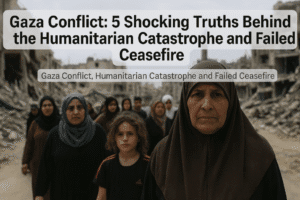Gaza Conflict: 5 Shocking Truths Behind the Humanitarian Catastrophe and Failed Ceasefire
The Gaza conflict has reached a critical impasse as Hamas rejects ceasefire talks, accusing Israel of a “starvation war” through its nine-week blockade of aid, while Israel greenlights an expanded offensive to dismantle Hamas and assert indefinite control over Gaza. With 2.1 million civilians trapped, the UN warns of catastrophic consequences, condemning Israel’s proposed privatized aid system as a violation of humanitarian principles and a tool to forcibly displace populations. Over 52,600 Palestinians have been killed since October 2023, including recent strikes on shelters like a UN school in Bureij refugee camp, which Hamas labels a “horrific massacre.” Israel defends its actions as targeting Hamas infrastructure, but far-right ministers openly advocate depopulating Gaza, drawing international condemnation.
The U.S. cautiously supports aid efforts, yet avoids challenging Israel’s strategy, while France calls the offensive “unacceptable” under international law. Civilians, facing famine and displacement, describe scavenging for survival as diplomacy collapses. Analysts warn the offensive risks entrenching cycles of violence, with no safe zones left and Gaza’s societal collapse accelerating. The world now confronts a grim reality: civilians are bargaining chips in a war where survival itself has become a weapon.

Gaza Conflict: 5 Shocking Truths Behind the Humanitarian Catastrophe and Failed Ceasefire
Hamas has declared further ceasefire negotiations “pointless” while accusing Israel of waging a “starvation war” through its blockade of Gaza. This hardening stance follows Israel’s security cabinet approval of an expanded military offensive aimed at permanently dismantling Hamas, displacing Gaza’s population southward, and establishing indefinite control over the territory. With 2.1 million Gazans trapped between siege tactics and urban warfare, the UN warns of catastrophic consequences, stating Israel’s plan would “inevitably lead to countless more civilians killed.”
The Aid Standoff: Weaponizing Survival
At the heart of the deadlock lies Israel’s nine-week blockade of humanitarian aid. While Israel claims Hamas diverts supplies for militant use, aid organizations report collapsing distribution systems and imminent famine. Israel now proposes replacing UN-led aid channels with a militarized model:
- Privatized distribution through corporate contractors
- Three military-controlled hubs in Rafah (a conflict zone under evacuation orders)
- “Family representatives” screened by Israeli forces to collect rations
The UN rejects this framework as a violation of humanitarian principles, arguing it uses aid to coerce population movement. “This isn’t relief—it’s demographic engineering,” stated a Gaza-based aid worker anonymously. Meanwhile, civilians describe foraging for wild greens and burning furniture to cook.
Military Escalation and Civilian Toll
Israel’s resumed offensive has already displaced 423,000 Gazans since March, with recent strikes killing dozens sheltering in schools and hospitals. The military defends its actions as targeting Hamas infrastructure, but collateral damage grows indiscriminate:
- 52,615+ reported killed since October 2023, including 2,507 since March
- 70% of Gaza now under Israeli evacuation orders or designated “no-go” zones
Hamas frames Israel’s expanded operations as a death sentence for remaining hostages, while far-right Israeli ministers openly advocate for Gaza’s total depopulation. Finance Minister Bezalel Smotrich recently stated plans to “concentrate” Gazans in the south before facilitating mass emigration—a policy France condemns as “unacceptable” under international law.
The Geopolitical Chessboard
The U.S. walks a precarious line, with President Trump pledging to “help supply food” while avoiding criticism of Israel’s strategy. Regional analysts suggest Israel’s delay in launching its offensive until after Trump’s upcoming visit reveals two calculations:
- Leveraging U.S. political cover for controversial operations
- Pressuring Hamas with a “window” to negotiate hostage releases
Yet Hamas shows no signs of capitulation. “Negotiations under starvation are surrender,” said senior official Bassem Naim, reflecting the group’s bet that global outrage over civilian suffering will eventually curb Israeli actions.
What Comes Next?
The trajectory points toward prolonged conflict:
- For Israel: Full-scale reoccupation risks guerrilla warfare in dense urban areas and global isolation.
- For Hamas: Surviving as Gaza’s governing force hinges on outlasting Israeli assaults.
- For Civilians: No safe zones remain. Overcrowded Rafah lacks infrastructure for displaced masses, while northern Gaza faces systemic collapse.
UN Secretary-General António Guterres warns the proposed offensive would “entrench cycles of violence for generations.” With both sides refusing to blink, Gaza’s population becomes collateral in a battle of attrition—one where food, medicine, and survival itself are now weapons of war.
You must be logged in to post a comment.